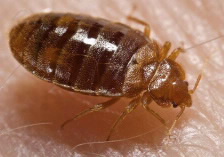FOR IMMEDIATE RELEASE
ACS News Service Weekly PressPac: June 23, 2010
First preliminary profile of proteins in bed bugs saliva
“Insight into the Sialome of the Bed Bug, Cimex lectularius”
Journal of Proteome Research
With bed bugs reemerging as a nuisance in some parts of the country, scientists are reporting the first preliminary description of the bug’s sialome — the saliva proteins that are the secret to Cimex lectularius’ ability to suck blood from its human victims and escape to bite again with risking a lethal slap. The findings, which could have medical applications in diagnosing bed bug bites and preventing the itch, appear in ACS’ monthly Journal of Proteome Research: “Insight into the Sialome of the Bed Bug, Cimex lectularius.”
In the report, Jose Ribeiro and colleagues point out that bed bugs have made reappearances in New York City, London, and other areas, sparking increased scientific interest in the allergic responses associated with their bites. Bed bugs belong to a group of insects that feed on blood throughout their lives and have been doing so successfully for at least 250 million years. That success depends in large part on proteins in their saliva, substances that make the victim’s blood vessels dilate (for a better flow of blood), inhibit clotting, and prevent immediate pain and itching that might evoke a lethal slap.
Using adult bed bugs from a government-maintained colony, the scientists removed salivary glands from male and female bugs, and analyzed the proteins to find unique enzymes that characterize the saliva profile of the bug. The substances could also offer insight into how insects evolved to a blood diet. “Independent of their function, these proteins may also be used for immune detection of humans and animals to bed bug exposure, or as part of desensitization vaccines,” the report says.
![]()
Contact
Science Inquiries: Michael Woods, Editor, 202-872-6293
General Inquiries: Michael Bernstein, 202-872-6042

substances that could lead to vaccines to
prevent allergic responses to the bugs’ bite.
Credit: Wikimedia Commons
(High-resolution version)

